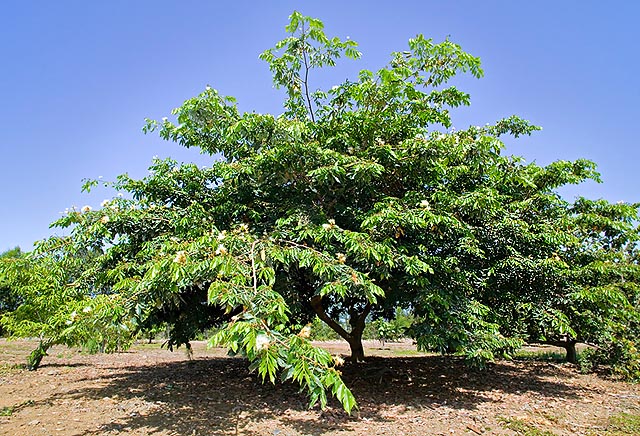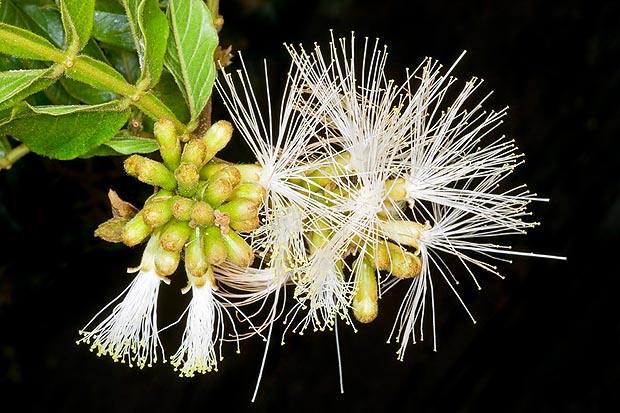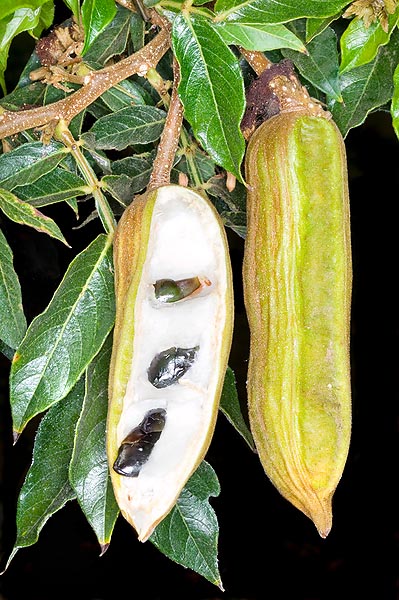Family : Fabaceae

Text © Pietro Puccio

English translation by Mario Beltramini

The tropical South American Inga edulis may be 25 m tall with a wide crown © Giuseppe Mazza
The name of the genus is the one utilized by the natives.
The name of the species is the Latin word “edulis” = edible, comestible, with obvious reference to the fruits.
Common names: ice cream bean, monkey tamarind (English); pois doux (French); anga, ingá, inga-cipó, ingá de macaco, maingá de metro, ingá macarrão, inga-rabo-de-mico (Portuguese – Brazil); chalaite, cuajiniquil, guaba, guaba de bejuco, guaba mecate, guaba chillillo, guama, guamo san Antonio, guamo santafereño, guava, guava machete, guavo-bejuco, inga cipo, jiniquil, pacae, pacay (Spanish); Affenschwanz-inga, Essbare Inga (German).
The Inga edulis Mart. (1837) is an evergreen fast-growing tree, tall up to about 25 m, with an enlarged crown rather flattened and an often twisted trunk, of about 30 cm of diameter, with a greyish bark.

The 8-12 cm thick racemes have white tubular flowers with protruding stamina © Giuseppe Mazza
Nectariferous glands are present between the pairs of leaflets.
The terminal inflorescences are formed by thick, 8-12 cm long, racemes with a 1,5-2,5 cm long tubular corolla, with five lobes, and several protruding stamina, about 4 cm long, which wither quickly.
The fruits are cylindrical pods, deeply streaked, even more than 1 m long, of 3-5 cm of diameter, containing numerous blackish, 3,5 x 1,2 cm, seeds surrounded by a white cottony aril with a sweet taste.
It easily reproduces by seed which has a short-lasting germination capacity, about two weeks; the germination takes place in two, three days, at times in the pod itself.
The fructification may begin, in the best conditions of cultivation, by the second year after the sowing.

Fruit and section with blackish seeds and edible pulp © G. Mazza
It has also a fairly good ornamental value due to its expanded and rather thick crown.
In order to grow better, it requires full sun and tropical and humid subtropical with heavy rainfalls climates, but it adapts also to seasonal climates, with three, four months of dryness.
Its cultivation may be tried in the warm temperate climates, as it can bear, for a short time, temperatures down to about -4 °C, even if with damage to the aerial part.
It adapts to different types of soil, even strongly acidic, and, being capable, as the other leguminous plants, to fix the atmospheric nitrogen enriching the soil and thus contributing to its fertility; furthermore, the deep and robust rooting apparatus helps in preventing the erosion along the slopes of the coffee plantations.
The pulp surrounding the seed, sweet and with a vanilla taste, is consumed as fresh, but from it they can get a juice at times utilized for preparing an alcoholic drink.
The seeds, consumed cooked as vegetables or roasted, are much popular in the origin countries. The leaves and the seeds, with their high contents in proteins, are also utilized as forage for the livestock.
Locally, its wood is used as combustible and as building material.
Finally, the seeds and the leaves are utilized in the traditional medicine as astringents in the intestinal diseases and as antirheumatics.
Synonyms: Mimosa inga Vell. (1827); Mimosa ynga Vell. (1827); Inga scabriuscula Benth. (1845); Inga benthamiana Meisn. (1848); Inga uncinata Spruce ex Benth. (1875); Inga vera sensu Brenan; Inga vera Kunth (1823); Feuilleea conferta (Benth.) Kuntze (1891); Feuilleea edulis (Mart.) Kuntze (1891); Feuilleea scabriuscula (Benth.) Kuntze (1891); Inga ynga (Vell.) J.W.Moore (1934).
→ To appreciate the biodiversity within the family of FABACEAE please click here.
